How to conduct water: the technology of work
For a normal life in a private house, and even for a holiday in the country, the household must be provided with a minimum set of amenities. The most important of them is the water supply, because without water, modern life is impossible, and subsistence farming is not for everyone. We will tell you how to hold water in the country with their own hands.

Water pipe laying
General moments

This article is intended, first of all, for those readers who are interested in laying the cold-water pipeline in a country plot: in a cottage, in a country house, in a house for permanent residence. Therefore, we will not touch upon all GOST instructions and highlight the technical nuances characteristic of industrial work and the construction of water mains.
In the country estate, there are four ways to provide water to the house:
- Pipe laying from the well. In this case, surface pumping stations are used, since the depth of the wells rarely exceeds 5–6 meters;
- Liner line from the point of exit of the well to the surface. If your site has a private well, then you can use the submersible pump to organize uninterrupted supply of high-quality drinking water to the house;
- If you are lucky and there is a natural spring of spring water nearby, then you can send some of the liquid for your own needs;
- Finally, you can tie in to the nearby central water supply. In this case, you do not need pumping equipment, but the permission of the company servicing the pipe is necessary.
Note! The most preferred source is an artesian well, lowered onto a limestone aquifer.
Laying of the external highway is underground. In the overwhelming majority of cases, the development of land is carried out in an open way by digging a trench, and only in special cases, when opencasting is impossible, is directional drilling or soil puncture applied.

For the construction of an autonomous system of a large amount of work is not required, therefore, you can dig a trench with an ordinary shovel and scrap. Of course, the use of technology will greatly simplify and speed up the process, and here everyone decides how best to conduct plumbing in the country, especially since it always comes up against financial possibilities.
The organization of the outer part
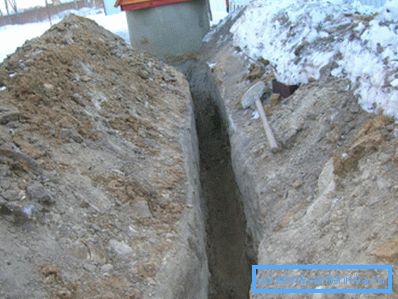
The outer part of the water transport system must be organized in accordance with a number of rules and regulations, otherwise its normal operation will be impossible. All these points are considered in the regulatory documents of SNiP and GOST, and we give those of them that are significant in our case.
So, we list the most important rules:
- The depth of the trench (the bedding) should be about 30 centimeters below the level of soil freezing in your area. You can find out the information in the relevant institution or use the online search. For most regions of the middle lane, the depth does not exceed 1.5 - 2 meters;
- The trench width according to GOST should be not less than 70 cm, however, in our case, this provision is optional. The width value is chosen so that it is convenient for you to work;
- The bottom of the ditch should have a small slope towards the source (0.001 - 0.002) to drain air and drain water from the pipe in case of repair or preservation of the system;
- It is advisable to choose the direct and shortest route, turns may require additional connections, and this reduces reliability;
- The bottom should be tamped. It is advisable to sprinkle it with sand, so that it is smooth, and the pipe lay on it with its entire surface;
- In order not to freeze the external pipeline in winter, it is insulated with foam plastic or a heating cable.
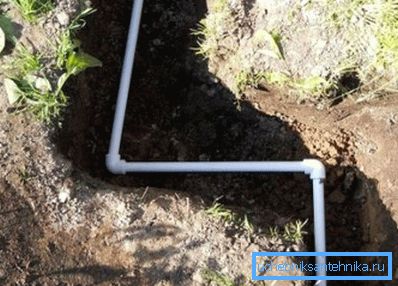
Note! When backfilling the highway, throw the earth into the corner of the trench, avoiding stones, lumps and construction debris so as not to damage the pipe.
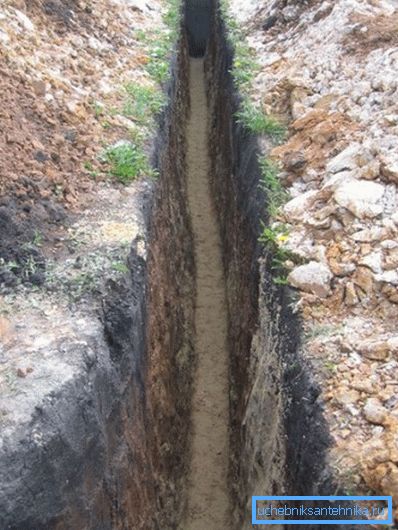
When using a submersible pump, it is allowed to lay the power cable in the same trench, but it must be laid in a plastic pipe and be 50 cm above the aquifer, but not closer than a meter to the ground.
Note! For the external line, a PND-pipe with a size of 32-50 mm is used. For risers, you can use pipes DN = 1 ?, and for horizontal wiring - ??,? ? or 3/8? made of steel, polypropylene or metal-plastic.
Equipment
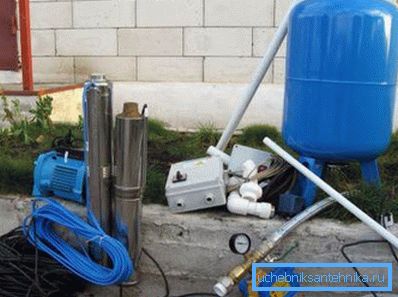
As you understand, the water to your house itself will not flow, and for its transportation you need special pumping equipment. Modern systems and stations demonstrate reliable and uninterrupted operation, and this requires minimal attention on your part.
For pumping fluid from shallow wells and sources, the depth of the water in which does not exceed 7 - 8 meters, a surface water pump is sufficient. As a rule, pumping stations are used today.
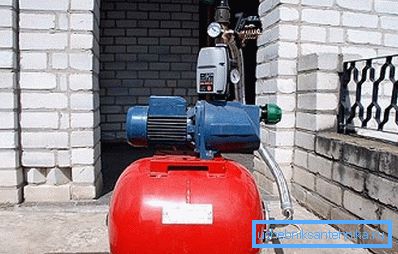
Such a station consists of a pump, hydroaccumulator and control automation. The pump pumps water into the tank where it is under pressure. As the reservoir empties and the pressure drops in it, the automation commands the re-activation of the pump.
When the pump is turned on, water is pumped until it reaches the upper pressure. At this point, the automatics sends the switch relay command again, and the pump stops. This principle provides the minimum number of motor starts, which significantly prolongs its service life, since the starting currents have a destructive effect on the motor windings and the contacts of the switches.
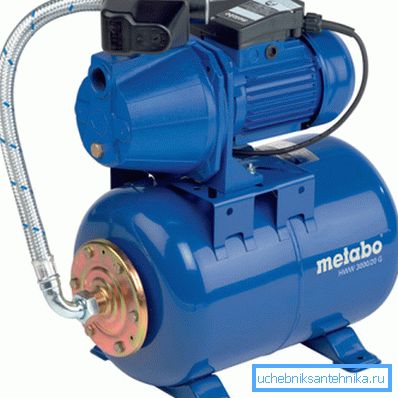
The volume of the hydroaccumulator is calculated according to the number of water intake points and the number of permanent residents of the house. As a rule, one average family of 3-4 people have enough tank for 50 liters.
Note! If the depth of the well allows the pump to pump additional distance of the horizontal line, the station is installed in the house. If the depth is more than 5 - 6 meters, then the pump is placed near the well.
In case you do a well connection, you will need a submersible unit. Its design allows pumping water to almost any height (up to 200 meters), since it does not suck up the liquid, but pushes it.
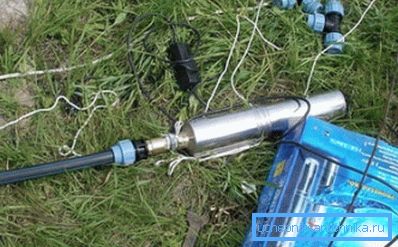
Three connections are connected to the pump at once: a power cable, a water pipe and a safety cable that allows you to reach the device if necessary and does not allow it to sink. A pump control unit is located in the house, which receives data from pressure sensors and, if necessary, switches the pump engine on and off.

Note! It also requires a hydro-accumulating tank, which is purchased separately and connected to the system.
Conclusion
Plumbing in a private house is necessary, so many owners of country plots and cottages are interested in the issue of its organization. If you have a nearby well, well, or other source of drinking water, you can build a pipeline yourself, and the video in this article will help you with this.